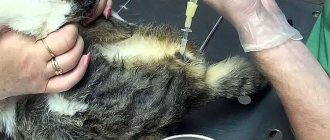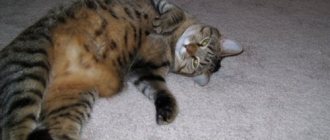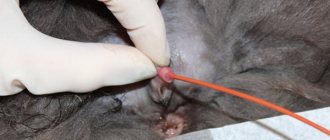Cystocentesis is a minimally invasive method of obtaining a sterile urine sample from dogs, cats and other pets by puncturing the bladder through the abdominal wall.
This method of sampling is quite common and not as scary as it might seem at first glance.
Cystocentesis is the gold standard for obtaining a urine sample for further cultivation of microorganisms, which makes it possible to identify the bacterium located in the bladder that is the cause of chronic cystitis. Allows you to determine the sensitivity of microorganisms to antibiotics in laboratory conditions. All this makes it possible to effectively treat cystitis and achieve remission.
Cystotomy: when is it necessary?
Surgery is always performed in animals under general anesthesia in compliance with the rules of asepsis and antisepsis. For such manipulations, the RosVet VC has an operating room that meets all the requirements for premises of this profile.
Direct indications for cystotomy:
- removal of uroliths (stones of different shapes, sizes and chemical composition);
- tissue sampling (biopsy) from the inner surface of the bladder;
- cystectomy (partial or complete) for neoplasms of various origins;
- traumatic injury (rupture) of the bladder;
- severe obstruction of the urethra by stones.
Cystostomy is considered a difficult operation for animals, as extensive trauma to the tissues of the abdomen and bladder occurs. The rehabilitation period is long, in contrast to endoscopic modern methods of stone removal (laser, shock wave therapy). Therefore, in veterinary clinics for animal urolithiasis, preference is given to minimally invasive techniques that minimize the risks of postoperative complications.
Important! At the RosVet VC, laser lithotripsy and laparoscopic cystotomy, performed under endoscopic control (on a monitor screen), are more often used to remove stones from the bladder. These techniques have fewer complications and faster tissue restoration. The animal returns to normal life as soon as possible.
How does the procedure work?
The purpose of the intervention is to remove the part of the urethra where the blockage occurred. Most often this is the area of the penis bone. Incomplete emptying leads not only to stagnation, but also to overstretching of the walls. Moreover, the diameter in the pelvic region of the urinary canal is quite wide, which eliminates re-occlusion.
After collecting tests and a control ultrasound, the veterinarian makes a decision on surgery . A catheter is installed. The urethra is washed. The bladder is cut, then all formations are removed. In some cases, preliminary castration is performed. In fact, the urethra is sewn to the skin, and a new hole is made nearby. The entire operation takes place under anesthesia.
The average duration of the operation is 30-40 minutes. The cost varies depending on the region and clinic. The price in Moscow, depending on the complexity, ranges from 2 to 45 thousand rubles.
What is required from the breeder?
Cystotomy is an abdominal operation that requires long-term monitoring of the pet at home. This means that the owner will not be able to leave the animal unattended for the first 5-10 days; there is a risk that the dog or cat will try to lick the wounds and tear off the stitches. A blanket and protective collar do not always help; especially persistent pets get rid of the obstacle with ease.
Important! If it is impossible to take a vacation during this time, then the RosVet EC offers a solution - to register the animal in a hospital under round-the-clock supervision by doctors. This is financially expensive, but 100% justified.
The pet is “delivered” to the owner either in a state of anesthesia or upon his return to consciousness. Next, antibacterial therapy (long-acting is available) must be prescribed (i.m., tablets), this is necessary to prevent the development of bacterial complications. That is, the owner must be able to give injections himself, or bring the dog or cat to the veterinary clinic for procedures. As an option: call a doctor at home by phone +.
Protection of external seams consists of using a blanket, which is removed only after the seams are removed (after approximately 10 days). To do this, you will need to visit the veterinarian again.
Indications for cystocentesis
- A severe case of chronic cystitis.
- Obtaining a sterile urine sample for bacteriological examination of the sample.
- The most reliable urine test. At the time of sampling the material by cystocentesis, the sample is as reliable as possible, since the doctor can collect the analysis, capturing sediment; urine does not pass through the urethra and genitals, which means that the detected sediment, epithelium and bacteria will correspond to the picture occurring in the bladder, and will not be distorted by additional factors. This increases the information content of urine analysis.
- Difficulties in collecting urine by owners at home.
- Urgent diagnostics.
- Acute urinary retention syndrome.
Condition of blockage of the urethra by a calculus/mucus plug/urethral spasm, neoplastic syndrome. This condition is urgent, as it entails a number of other complications, including bladder rupture and peritonitis, acute renal failure. If it is impossible to catheterize the urethra, they resort to cystocentesis with a high risk of complications.
Possible complications and prognosis
At the RosVet VC, the cystotomy operation is worked out to the smallest nuances; complications arise in 0.1% of cases, when the risks practically cannot be calculated in advance. Possible list:
- anesthetic risks; it is impossible to predict how anesthesia will affect your pet;
- frequent hematuria in the first 3-4 days, a natural process, as the walls of the bladder heal; if blood in the urine continues longer, an ultrasound should be done and the cause should be identified;
- urethral obstruction;
- a poorly formed seam on the bladder leads to leakage of urine into the abdominal cavity;
- small fragments of stones are not removed completely enough, which in the future can cause relapse of urolithiasis.
It is necessary to monitor the condition of the animal and the wound for 14 days after the operation, which without proper care can become infected, inflamed and suppurate. If swelling, redness, serous or purulent discharge occurs in the suture area, or a serous cavity (seroma) has formed, you should urgently call a veterinarian.
The prognosis for cystotomy is generally favorable if the operation is performed in modern conditions with the latest equipment. Therefore, it is important to choose a clinic where there are all the conditions for performing safe surgical interventions - such as the RosVet VC!
For diseases of the urinary system in cats, cystostomy is indicated in certain cases. This is a serious operation on the bladder, which is necessary in cases of intoxication, difficulty in the outflow of urine or bleeding. It is important to understand that refusing it or taking a long time to make a decision can lead to the death of your pet.
Veterinary clinic of Dr. Shubin
Description and indications
Cystotomy is a surgical dissection of the bladder with access through the abdominal cavity.
The main indication for this manipulation is the surgical removal of stones from the bladder. Also, cystotomy may be indicated for collecting tumors from the bladder (eg polyps) and obtaining material for research. In developed countries, laser lithotripsy of stones through the urethra and laparoscopic cystotomy under endoscopic control are gaining increasing popularity for the removal of bladder stones. This type of intervention is characterized by fewer postoperative complications, but requires expensive equipment and a high degree of professionalism. If the animal owner wishes, doctors can recommend where to go in Russia. Our veterinary clinic has practiced purely surgical cystotomy; there is no equipment or skills for performing endoscopic operations.
The essence of the cystotomy operation: in an animal under anesthesia, a surgical incision is made in the lower part of the abdominal wall along the midline, starting just below the navel and ending in the area of the pubic bones. In this case, the bladder is exposed, removed from the abdominal cavity, retaining sutures are placed on it and a dissection is made along the lower wall. The length of the incision depends on the size of the stones or is dictated by the need for manipulations in the bladder cavity. When removing stones, after mechanical sampling, the bladder is washed with saline through the urethra to capture small-volume uroliths.
Once the manipulation of the bladder cavity is complete, the incision is closed with absorbable sutures, the bladder is returned to the abdominal cavity, and the abdominal wall is sutured in a routine manner. External sutures are placed on the skin.
Postoperative care
After cystotomy, the animal is handed over to the owner either consciously or when signs of the end of the anesthesia drugs are reached and in a stable condition. After the operation, antibacterial therapy is a prerequisite for a period of 2 weeks; for this purpose, a single injection of a long-acting antibiotic (“Convenia”) can be performed, or the owner himself administers the drug (tablets, injections).
External sutures are applied to the skin incision and their protection is required for a 2-week period; for these purposes, various options of blankets or an Elizabethan collar can be used. Protection is carried out to prevent the animal itself from licking the seams; sometimes it can cause the seams to separate with its tongue or teeth. After this period has expired, the stitches must be removed, i.e. You must come to the veterinary clinic for an appointment. After the stitches are removed, the animal does not require wearing protective blankets or a collar.
To process sutures, it is better to consult with the staff of a veterinary clinic. In most cases, the seams only require protection from licking and grow together well without any treatment. In a calm animal or with severe inflammation of the sutures, applying antibiotic ointment (Levomekol, etc.) 1-2 times a day may be beneficial. Postoperative antibacterial therapy with systemic drugs protects sutures better than local treatments.
Possible complications
In general, cystotomy is quite easy to perform, its implementation has been practiced in our veterinary clinic, significant complications rarely arise, but, like any other operation, it can carry serious adverse consequences. Below is a list of the most likely complications:
• Anesthetic mortality – it is no different from that for other types of interventions; each anesthesia has the potential to kill the animal.
• Frequent urination with blood in the first 3 days after surgery is an expected complication, the incision and subsequent healing of the bladder wall entails these manifestations. If these signs do not subside within a few days after surgery, you should consult a veterinarian.
• Obstruction (blockage) of the urethra - there is only a small probability of developing this complication; a urethral catheter is not used in world practice to prevent blockage. If the animal tries to urinate to no avail and general depression increases, then it is necessary to urgently seek professional help.
• Failure of bladder sutures – leads to urine leakage into the abdominal cavity and deterioration of the animal’s general condition. Like the previous complication, postoperative violation of the integrity of the bladder is extremely rare; if the general condition of the animal worsens, it is necessary to seek help.
• When removing and washing out stones from the bladder, the probability of missing small conglomerates is about 20% (data from studies in a modern veterinary hospital), in the short term this does not cause significant complications, but in the future it can accelerate the formation of urinary stones (the risk and rate of relapse formation increases urolithiasis).
• Short-term complications (within 14 days) may include inflammation and infection of the wound, this is accompanied by redness and swelling of the operation area, serous fluid may develop, or the formation of a serous cavity (seroma). If these complications occur, again, you should immediately contact a veterinary clinic.
In general, an animal after surgery requires careful monitoring of its condition; if the slightest doubt arises, you should consult a doctor at a veterinary clinic.
Forecasts
Cystotomy in our veterinary clinic is a routine and proven operation, in the vast majority of cases it leads to the resolution of the task (eg stone removal) and the animal’s recovery. In general, the prognosis for recovery is favorable.
Veterinary clinic of Dr. Shubin, Balakovo
Risks and complications
The animal can take a long time to recover after the intervention.
Cystostomy is a complex operation, which does not exclude recurrence of the disease and postoperative complications. It is important to understand that even full compliance with veterinarians’ recommendations cannot always prevent the development of a particular pathology. The following complications occur after surgical treatment:
- Prolonged recovery period. In older cats, immunity is reduced, so healing of wounds and the appearance of appetite occurs later.
- Urinary incontinence. The cause may be nerve damage or simply long catheterization after surgery.
- Outflow of urine into the abdominal cavity. Manifested by a small amount of urine, fever, poor appetite. Repeated surgery is required.
- Seroma or abscess at the suture site. In the first case, the accumulated inflammatory fluid resolves on its own, in the second, surgical treatment and a course of antibiotics are required.
- Hernia formation. The need for plastic surgery of this defect is discussed with the veterinarian after examining the animal.
Doctors remind cat owners that if they notice alarming symptoms in time and seek veterinary help, the need for surgery will be minimal. You should feed your cat healthy food, monitor its drinking regime, and for preventative purposes, consult with specialists so that your pets never get sick.
Bladder capacity in cats
» Bladder
Treatment tactics for acute urinary retention in cats.
Upon admission to the clinic, it is necessary to carefully collect anamnesis from all animals, identifying age, living conditions, nutrition, duration of the disease, frequency and duration of attacks of acute urinary retention, as well as the number of bladder catheterizations. Clinically determine the general condition of the animal, as well as palpation determine the size and density of the bladder. It is imperative to perform an ultrasound, assessing the size of the bladder, the tone and thickness of its walls, the presence of stones and neoplasms in the lumen of the bladder, their number and size, as well as the diameter of the proximal part of the urethra.
After analyzing the examination results, you can choose one of the following treatment methods:
1. A young cat has an attack of acute urinary retention for the first time, the duration of the disease is no more than a day, the abdomen is soft, the bladder is no more than 8 cm in diameter - elastic consistency, in its lumen there is a small amount of fine sand (possibly the absence of stones), the tone of the walls The bladder is preserved, the urethra is not enlarged. General condition is satisfactory.
The animal is shown simple hydraulic removal of the “plug” from the distal part of the urethra using a catheter or a blunt injection needle, and rinsing the bladder 3-4 times. This manipulation can be performed without anesthesia. In cases of aggressiveness or violent reaction of the animal, a well-proven sedative in veterinary medicine - vetranquil - should be administered at a dose of 0.025 - 0.05 ml per 1 kg of weight. Subsequently, it is necessary to prescribe uroseptics, antispasmodics, and after a general urine test, an appropriate diet for the prevention of urolithiasis.
2. This is not the first time that a young or middle-aged cat has had urinary retention. Previously, the attacks went away on their own, either after the prescription of antispasmodics, or after instrumental removal of the urethral “plug”. The duration of the attack is 1-2 days. The bladder is up to 10 cm in diameter, has a dense elastic consistency, the tone of its walls is preserved. In the lumen of the bladder there is a fairly large amount of fine sand and some flocculent suspension. General condition is satisfactory.
Under anesthesia, the “plug” consisting of sand and mucus should be washed out of the urethra and a catheter should be inserted into the bladder of the maximum possible diameter. After the latter, under ultrasound control, thoroughly rinse the bladder several times with the obligatory removal of sand and mucus. The catheter is sewn to the skin and left in the bladder for 4-8 days. If it becomes clogged, rinse again. It is immediately necessary to prescribe uroseptics, antibiotics, if necessary, hemostatics, intravenous or subcutaneous administration of fluids, and symptomatic therapy. The catheter should be removed once the urine color has returned to normal. After recovery, it is necessary to carry out preventive therapy.
3. The general condition of the animal, regardless of age, moderate or severe. The cat refuses food, water, and may vomit. Urinary retention may be the first time, but most often 3-4 times. The duration of the attack is 2-3 days. The abdomen is usually soft, a dense, tense bladder 10 or more centimeters in diameter is palpable. Ultrasound examination reveals thinning of the walls of the bladder, or, conversely, thickening of the walls (with a long history of urolithiasis), abundant flocculent suspension, a large amount of sand and stones with a diameter of up to 0.3 cm, dilatation of the urethra more than 0.5 cm.
Under general anesthesia, it is necessary to perform a perineal urethrostomy.
The scrotum, testicles and penis are excised as a single block. The pubic-cavernous ligaments are intersected in front, after which it becomes possible to lengthen the urethra due to its pelvic section. Next, the urethra is separated to the ischiocavernosus muscles, which intersect in the transverse direction. The bladder must be rinsed through the thickest possible catheter until stones and mucus are completely washed away, preferably under ultrasound control. In case of complete absence of bladder tone, a catheter must be left in the latter for 4-6 days. In the postoperative period, in addition to uroseptics, antibiotics and hemostatics, it is mandatory to prescribe intravenous or subcutaneous fluids with symptomatic and restorative therapy. Skin sutures are removed after 10-12 days.
4. The cat is in serious condition, refuses food and water, and vomits repeatedly. Urinary retention for 2-3 or more days. The bladder is at least 10 cm, hard as a rock. In the lumen of the bladder there are dense clots, sand and stones up to 0.3 or more centimeters in size. The walls of the bladder are thinned, the urethra is dilated.
Transabdominal urethrostomy is indicated for such an animal (Telpukhov V.I. et al. 2000). In the postoperative period, measures similar to the previous ones are performed.
Such a differentiated individual approach will significantly reduce postoperative mortality, complications and relapses of acute urinary retention in cats, both in the immediate and long term.
Approximate treatment plan.
-Antibiotics - for 5-7 days, lincomycin 0.3 ml 2 times a day or cephalosparins (kefzol, claforan, ceparin, cefazalin......) 0.2 g. 2 r.v.
-Uroseptics - 5 - NOK, furagin, palin, etc. 7 days 1/4 t 2-3 r.v. Herbal decoction: bear ears, juniper berry, half-pol, (nettle - if urine contains blood). – Brew 1 tablespoon of the mixture in 1 glass, 15 minutes in a water bath. 2-3 tsp. 2-3 days a day 10–15 days.
-In case of dehydration, give water - rehydron. IV or subcutaneous fluids with vitamins.
Telpukhov V.I.
Where is a cat's bladder?
merqlove
Bladder catheterization sometimes becomes the only possible way to remove urine and save the animal’s life. Urolithiasis in cats is the process of stone formation in the bladder and urethra. Clinically, when the disease occurs, urinary retention or urine leakage in droplets, and the appearance of blood in the urine are observed. The cat may sit in the litter box for a long time and try to urinate to no avail. In addition, the primary symptom of the disease is frequent, prolonged, painful urination. Urine is discolored and smells unpleasant. The cat has to undergo bladder catheterization to save his life. The photo shows stones in the MVS.
draglicat
Igor Saprykin Expert (324), voted 3 years ago We cannot determine how full the bladder is in a cat with urolithiasis. Voting for the best answer Olga Sergeevna Znatok (265) 3 years ago I don’t know, but they poop immediately after eating GHOST and SHADOW Artificial Intelligence (108997) 3 years ago After 15-20 minutes. Diana Thinker (7666) 3 years ago It’s different for everyone. We have a cat and a cat. The cat walks after about an hour, and the cat after 2 hours.
Kianu
For the first time I hear that it can be treated. The first time I hear that bladder inflammation can be treated with massage. Change doctor urgently! Antibiotic injections or, in extreme cases, drops are used. Sometimes a bladder massage is prescribed, but not as a treatment, but in cases where there is stagnation of urine and it is necessary to activate its removal from the body, but only a doctor should do the massage.
urbansheep
The cat is naturally very fertile. After she left her natural habitat for our apartments, her fertility lost its biological meaning and became a source of difficulties for the owner, and also poses a threat to the life of the cat herself. Repeated births of a cat and feeding kittens lead to premature wear and tear of the body and a shortened lifespan. If the cat is not allowed to mate, while preserving its reproductive organs, then natural renewal of the hormonal fund does not occur, which leads to disruption of the structure of the reproductive cycle and the emergence of hormonally dependent malignant tumors.
MaSta-KeKc
Before visiting the forum, read the topic: How to properly consult a veterinarian, as well as the list of answers to frequently asked questions, this will help you save your time and get an answer to your question faster.
MrTigra
Stefani Shelti (Bi kolor) Genius (51197) 3 years ago Could you please indicate your region? Cost of veterinary services vary somewhat by region. ———————————————-From the price list for veterinary services in Moscow: * Catheterization of the bladder of cats, cats (one head) 353.00 * Sanitation of the bladder, lavage of the uterine cavity (one head ) 231.00 Plus the cost of the initial inspection. All rates include VAT. Rachel Nechamovich Pro (956) 3 years ago Yes, by the way, I believe you understand that a catheter is not a replacement for drug treatment.
nikuly
Acute urinary retention in cats (feline urolithiasis, urolithiasis, secondary urocystitis) Case history I ate a ton of salt for urolithiasis. My naive behavior towards the then tiny pet, namely, the use of various popular foods and other delicacies for cats, brought my cat to a catheter at the age of 8 months. However, this situation happened for the first and last time. As I later became convinced, an attentive and competent attitude towards pets, supported by contacts with professional veterinarians, and the use of primary and secondary treatment methods in combination dispel the fog of hopelessness in the face of many diseases. Currently, my cat (not neutered) is almost 15 years old.
Anastasya844
Hello! I would like to hear advice from doctors and from owners who have experienced similar situations. Cat Semyon, 5 years old, breed - Neva Masquerade. Every spring and autumn there are attacks of urolithiasis or cystitis, I am confused. 2.5 years ago we started a course of injections, after that, every season, as soon as I started peeing all over the apartment, I took drops of Canephron, 30 drops a day for about 2 weeks. This time I started peeing, I began to drip Canephron, literally a week later we noticed blood on the cat after using the toilet (maybe it was there before, the cat goes into the litter tray and cleans itself). We immediately went to the hospital. On Saturday, September 20, they gave injections - in the evening spasms and convulsions began (they said the body was poisoned by urine). On Sunday, September 21, the doctor manually cleaned the bladder of sand and inserted a catheter to drain urine. He said that the sand was coarse and that the cat would not survive the operation under general anesthesia.
NeGOdyaikA
Stefani Shelti (Bi kolor) Genius (51197) 4 years ago This massage is always performed by the owner according to the indications of the current disease, after a complete diagnosis and confirmation of urolithiasis in cats. The main thing is that there are no serious disturbances in the functioning of the kidneys and adrenal glands. Turn the animal over onto your lap in the toilet room. And you begin to stroke the cat’s lower abdomen and genital area clockwise (you can use a damp cloth). gradually increasing the pressure in a circular motion towards the bladder. At this moment, with proper massage, a white paste (accumulation of salts and sand) will come out of the cat’s urethra. Our cat even had similar white sticks fly out and stick to the door of the toilet room. The cat behaved very calmly.
Pure
Urinary retention in cats is a symptom of illness. The cat often begins to sit down in the litter box, spin around in the litter box, meow, worry, sit in the litter box for a long time, but does not go to the toilet. Sitting down in the tray, the cat’s stomach may tense convulsively; it is clear that the cat is pushing and it is painful for her. Often urine comes out drop by drop, the stream may be interrupted several times, and there are droplets of blood. Urinary retention is easily distinguished from kidney disease, in which the urine takes on the color of meat slop. Urinary retention can be a symptom of kidney and genitourinary diseases. Cats are more susceptible to diseases of the genitourinary system, including urolithiasis, because their urethra is several times narrower than that of cats.
SoLa
Contents: Causes Symptoms Treatment Prevention One of the most insidious and difficult to treat cat diseases is cystitis. Not only the pets themselves suffer from this problem, but also their owners. A qualified veterinarian can tell you how to treat cystitis in a cat. However, it is not always possible to seek help from a specialist. Causes Cystitis in cats is an inflammation of the mucous membrane of the bladder. This organ has a hollow structure and is capable of increasing and decreasing in size. The mucous membrane of the bladder is constantly exposed to stress: when urine accumulates, it stretches greatly, and after emptying it shrinks, forming many folds.
Comment Cancel
Urethrostomy and cystotomy
There are two types of urethrostomy:
- Perineal. A hole for urine output is formed in the area between the anus and the scrotum. During the operation, the penis is removed, since it contains two narrowings of the urethra. A catheter is inserted into the formed hole. Thus, the urinary canal becomes wider and allows stones up to 5 mm in diameter to be removed along with urine.
- Prelonnaya. It is carried out when it is impossible to form a urinary canal in the perineal area. In this case, the urethra is brought out onto the abdominal wall.
To remove stones, a cystotomy is performed - a dissection of the bladder.
After a urethrostomy, your cat may experience urinary incontinence.
Unfortunately, for the animal's owners, the process becomes constant and uncontrollable. This is due to the absence of a sphincter at the end of the new excretory duct.
Urethral obstruction in a cat
Veterinarians note that this disease occurs just as often in cats compared to cats. But no one usually notices her. After all, obvious manifestations are not typical for her.
Preparation
At this stage, the animal undergoes the following examinations:
- Ultrasound of the abdominal cavity.
- Blood test (general and biochemical).
- Analysis of urine.
- X-ray of the urinary system.
Proper preparation for surgery is the key to the animal’s recovery.
It is extremely important to identify possible problems at the preoperative preoperative stage:
- exclude renal failure;
- diagnose and correct the condition of sepsis and anemia;
- predict the impossibility of placing a catheter in an animal.
Examination of the cat before surgery
The essence of the operation
The purpose of surgery is to ensure unimpeded passage of urine from the body. The operation is performed to create a new, wide excretory passage in case of complete blockage of the urethra.
Progress of the operation
The entire operation takes up to 45 minutes. The process uses general inhalation anesthesia or epidural anesthesia.
The order of the operation may vary due to different characteristics and pathologies of the disease.
At the preparation stage, during ultrasound and radiography, the location of the stones and their number are determined. Next, the urethra is washed and a catheter is inserted. All stones present in it are washed into the bladder cavity.
Urethrostomy for urolithiasis in a cat
If the pet is not castrated, castration is performed with the removal of the penis. Then access to the bladder is formed and all stones are removed. The next step is urethrostomy.
Lack of urination in a cat
Does your cat spend a long time in the litter box, spin around, often sit down and make sounds? But the result is zero or urine is released drop by drop? Such characteristic symptoms indicate urinary retention and lack of urination in the cat.
The inability to empty the bladder in the usual way (urethral obstruction, acute urinary retention) indicates the occurrence of a life-threatening condition for the pet or USC - urological syndrome.
Causes and symptoms of pathology
Lack of urination can develop for the following reasons:
· Inflammation of the lower parts of the urinary organs (urethritis, cystitis);
Without urination, the urethra can become clogged with mucus, blood clots, crystals and small stones.
As a rule, the absence of urine separation is accompanied by the following symptoms in cats:
· Frequent trips to the litter box, urine excretion in small portions, sometimes the cat leaves marks in “wrong places”;
· Difficulty and painful urination;
· Detection of blood, mucus and salts in urine during laboratory testing.
What should the owner do?
If such symptoms are detected, you must IMMEDIATELY take the cat to a veterinary center! In the absence of urination, the cat develops acute urinary retention and, as a result, the accumulation of toxins in the blood, poisoning of the entire body and death in agony.
What will the doctor do?
The owner must inform the veterinarian when the first signs of pathology appear. The doctor will assess (by palpation) the condition of the bladder and the degree of its filling.
Treatment involves removing the blockage and restoring normal urine flow. It’s good if the cat can pee with gentle pressure on the bladder with your fingers. But in most cases, a serious procedure has to be performed - catheterization (installation of a urinary catheter).
It is best not to resort to radical measures, since this procedure is quite painful and will require sedation, and in some cases, general anesthesia. Most cats tolerate this procedure quite easily, but many require perineal urethrostomy - an emergency operation.
But restoring the flow of urine is not the only problem that the veterinarian will have to solve. Cats that do not urinate develop dehydration and accumulate toxins. Symptomatically, poisoning of the body is manifested by vomiting, nausea, general weakness and loss of appetite. Such complications require detailed treatment and monitoring using biochemical blood tests and sometimes using gas and electrolyte tests.
It is important to remember that partial urinary retention can be no less dangerous and also requires treatment.
Treatment in hospital
If a cat cannot go to bed for more than 1-2 days, a condition that threatens his life occurs. That is why it is better to leave him in hospital treatment for the period required to normalize his condition.
When the cat “comes” home
What should the owner do after the cat is discharged from the hospital? Correctly follow all recommendations received from your veterinarian regarding care, feeding and prevention.
The main task is to monitor the urination pattern and the general condition of the pet. It is important to remember that in the first weeks there is a high risk of recurrence of urinary outflow disorders.
Veterinary center Dobrovet
Ascites in dogs - ascites (from the Greek askites, askos - leather bag, belly) - is nothing more than the release and accumulation of blood plasma ultrafiltrate in the peritoneal space due to increased capillary pressure in the veins of the liver, peritoneum and lymphatic vessels in chronic heart diseases , liver and neoplasms, as well as the result of inflammatory exudation in infectious diseases.
Aggression of a domestic cat is nothing more than improper raising of kittens. The owners do not pay attention to the behavior of the little pet, they forgive him little pranks, without realizing that the claws will later turn into strong, sharp hooks.
Feline leukemia (FeLV, Feline Leukemia Virus) is a disease caused by an RNA virus from the Retroviridae family. The disease is characterized by predominant damage to the bone marrow and lymphoid tissue cells. The leukemia virus can be transmitted in various ways: contact, sexually, vertically (from a cat to kittens in utero or during feeding), through bites.
Urethrostomy of cats
Feline urethrostomy is an operation during which a permanent opening (urethrostomy) is formed between the wide part of the urethra and the skin of the abdominal wall.
Content
- Indications for surgery
- Preparing for surgery
- Progress of the operation
- After operation
- Complications
Indications for surgery.
The indication for this operation is mainly unremovable or recurrent obstruction of the distal (closer to the urethra) part of the urethra. The urethra is the canal through which urine is drained from the bladder to the urethra. In cats, the urethra has an uneven width along its length. The closer to the urethra, the thinner the urethra. This is where blockage most often occurs. The plug is most often formed by salts (with urolithiasis) or blood cells (with cystitis). Also, urethral obstruction can develop due to trauma, tumors and inflammatory diseases of the urethra.
Urethrostomy increases the risk of developing infectious diseases of the urinary system. Therefore, it is resorted to only in cases where conservative (without surgery) treatment has not produced results.
Preparing for surgery.
Cats undergoing urethrostomy almost always have significant urinary problems. If urination is impaired, acute renal failure may develop. It is important to identify and correct this condition before surgery. Sometimes, if catheterization is impossible, cystocentesis may be required - puncturing the bladder and draining urine out through the abdominal wall. With prolonged inflammation of the urinary system, anemia and sepsis can also develop, which also requires timely diagnosis and correction. Examination before urethrostomy may include:
- Abdominal ultrasound
- General blood analysis
- Blood chemistry
- General urine analysis
- X-ray (including contrast) of the urinary system
Progress of the operation.
For various pathologies, the operation will have its own characteristics. In the most common case of urolithiasis, control ultrasound and radiography are performed before surgery to clarify the location of the stones and their number. Next, urethral lavage and bladder catheterization are carried out to remove all possible stones from the urethra into the bladder cavity. If the cat is not neutered, castration is performed. Next, access is made to the bladder, from the cavity of which all concrements (stones) are removed. Next, a urethrostomy is performed, during which a wide part of the urethra is sutured to the skin. The penis is removed during the operation.
In most cases, the operation is performed under general inhalation and epidural anesthesia and takes 25-45 minutes.
After operation.
Postoperatively, the cat will wear a protective collar to prevent licking. If access to the bladder cavity was made, a urinary catheter is placed, usually for a day. Antibacterial and painkillers are prescribed. Infusion therapy is carried out according to indications. Urination and general condition are controlled. The animal is usually discharged from the clinic the next day after surgery, but it may take longer, depending on the cat’s condition.
At home, you will need to continue wearing a protective collar, cleaning your stitches, and giving antibiotics 1-2 times a day. Sutures are removed 12-14 days after surgery. For urolithiasis, an appropriate diet and constant access to fresh water are recommended.
Complications.
Cats undergoing urethrostomy are prone to urinary tract infections. Inflammation and overgrowth of the urethrostomy is also possible, most often due to the animal licking the surgical area. With urolithiasis, recurrence of blockage of the urethra by large stones is possible.
The article was prepared by P.A. Kuznetsov, veterinary cardiologist, anesthesiologist at MEDVET © 2015 SEC MEDVET











